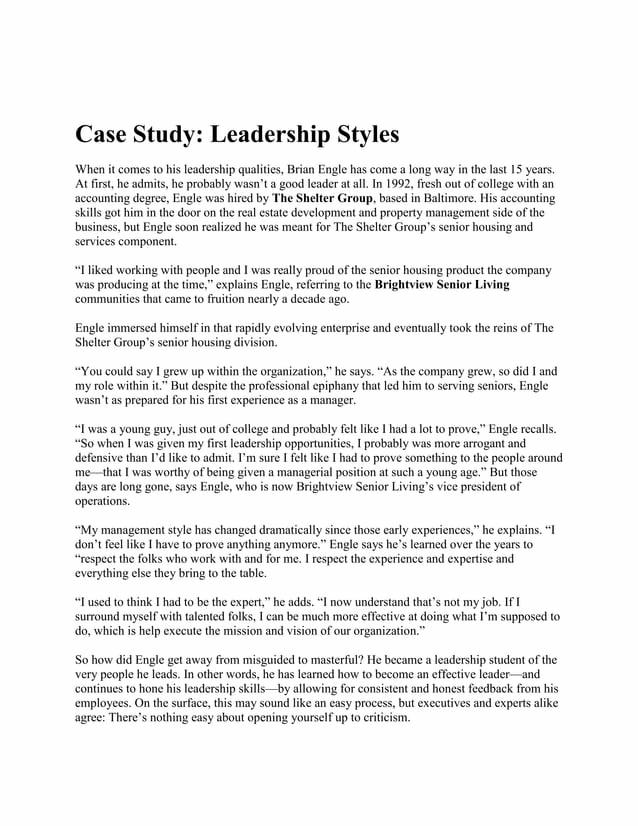Leadership is one of the most critical elements that drive success in organizations. Different leaders adopt various styles based on their personality, the culture of the organization, and the specific challenges they face. Owen McIntire, a prominent figure in the business world, presents a fascinating case study in leadership. This article explores McIntire’s leadership style, its evolution, and its impact on his organizations and teams.
Understanding Owen McIntire’s Background
Before delving into McIntire’s leadership style, it is essential to understand his background. With over two decades of experience in the corporate sector, McIntire has held several leadership positions in multinational corporations. His educational background includes a degree in business administration and an MBA from a prestigious university, equipping him with the theoretical knowledge necessary for effective leadership.
Leadership Style: An Overview
Owen McIntire’s leadership style is often characterized as transformational. Transformational leaders inspire and motivate their teams through a shared vision, fostering an environment of collaboration and innovation. McIntire’s approach can be broken down into several key components:
- Visionary Leadership: McIntire emphasizes creating a clear and compelling vision for the future. He communicates this vision effectively, ensuring that all team members understand their roles in achieving it.
- Empowerment: Rather than micromanaging, McIntire empowers his team members, allowing them to take ownership of their tasks and make decisions.
- Open Communication: McIntire fosters an environment of open dialogue, encouraging feedback and discussions that promote growth and understanding.
- Emotional Intelligence: A hallmark of McIntire’s leadership is his high emotional intelligence, enabling him to connect with team members and understand their needs.
The Transformational Leadership Approach
McIntire’s transformational leadership style can be best understood through his actions during a significant organizational change at one of his previous companies. Faced with declining market share and employee dissatisfaction, he implemented a comprehensive change strategy.
Case Study: Organizational Transformation
When McIntire became the CEO of a mid-sized technology firm facing economic challenges, he recognized the need for a cultural overhaul. The following steps illustrate how his leadership style played a crucial role in this transformation:
- Assessment of the Situation: McIntire conducted an extensive analysis of the company’s internal and external environments, gathering insights from employees at all levels.
- Vision Communication: He articulated a new vision focused on innovation and customer-centricity, ensuring that every employee understood the direction the company was heading.
- Team Empowerment: McIntire established cross-functional teams to promote collaboration and encouraged employees to contribute ideas.
- Recognition of Achievements: He implemented a recognition program to celebrate employee contributions, boosting morale and engagement.
The results were remarkable. Within two years, the company reported a 30% increase in market share and a significant rise in employee satisfaction scores. This case exemplifies how McIntire’s transformational leadership style effectively addressed challenges and created a thriving organizational culture.
Leadership Techniques and Strategies
Owen McIntire employs various techniques and strategies that align with his leadership style. Here are some notable examples:
- Mentorship Programs: McIntire believes in nurturing future leaders. He initiated mentorship programs that pair junior employees with seasoned professionals, fostering growth and development.
- Continuous Learning: He promotes a culture of continuous learning, encouraging employees to pursue professional development opportunities.
- Inclusive Decision-Making: McIntire values diverse perspectives in decision-making processes, often involving team members in brainstorming sessions to generate innovative solutions.
- Feedback Mechanisms: He established regular feedback loops, ensuring that employees can voice their opinions and contribute to the company’s evolution.
The Role of Emotional Intelligence in McIntire’s Leadership
Emotional intelligence (EI) is a critical component of effective leadership, and McIntire exemplifies this quality. His ability to connect with team members on an emotional level enhances trust and collaboration. Some specific EI traits that McIntire exhibits include:
- Self-Awareness: McIntire understands his strengths and weaknesses, allowing him to manage his emotions effectively.
- Empathy: He actively listens to his team members, demonstrating genuine concern for their well-being.
- Conflict Resolution: McIntire approaches conflicts with a calm demeanor, seeking to understand different perspectives and find common ground.
- Motivation: His passion for the company’s vision inspires others to strive for excellence.
Challenges Faced by McIntire
No leadership journey is without challenges. McIntire has encountered several obstacles throughout his career, including:
- Resistance to Change: During the organizational transformation, some employees were resistant to new processes and ideas, fearing they might lose their jobs.
- Balancing Stakeholder Interests: McIntire often faced the challenge of aligning the interests of various stakeholders, including shareholders, employees, and customers.
- Maintaining Work-Life Balance: As a transformational leader, the pressure to perform can be overwhelming, requiring him to find balance in his own life.
McIntire navigated these challenges through open communication, transparency, and a steadfast commitment to the company’s vision, ultimately fostering a resilient organizational culture.
Impact on Organizational Culture
Owen McIntire’s leadership style has profoundly affected the organizational culture within his companies. Some key impacts include:
- Increased Engagement: Employees feel more engaged and committed to their work due to the empowerment and recognition they receive.
- Innovation: The culture of collaboration and open communication has led to increased innovation, with teams regularly generating creative solutions to problems.
- Retention of Talent: By fostering a positive work environment, McIntire has contributed to higher employee retention rates.
- Customer-Centric Focus: The shift toward a customer-centric approach has improved customer satisfaction and loyalty.
Conclusion: Key Takeaways

Owen McIntire’s leadership style serves as an inspiring case study for current and aspiring leaders. His transformational approach, characterized by visionary leadership, empowerment, open communication, and emotional intelligence, has enabled him to navigate complex organizational challenges effectively.
Key takeaways from McIntire’s leadership journey include:
- The importance of a clear vision in guiding teams toward common goals.
- Empowering employees fosters ownership and drives engagement.
- Open communication is vital for building trust and collaboration.
- Emotional intelligence plays a crucial role in effective leadership.
As organizations continue to evolve in an increasingly complex landscape, leaders can draw valuable insights from Owen McIntire’s approach, ensuring they inspire and lead their teams to success.


